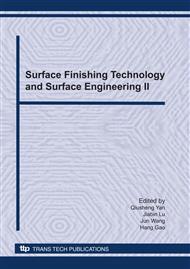p.249
p.255
p.260
p.265
p.271
p.277
p.282
p.288
p.293
Interface Temperature Measurement and Experimental Studies of Super-High Speed Polishing of CVD Diamond Films
Abstract:
Super-high speed polishing of diamond film is a newly proposed method due to its outstanding features such as low cost and simple apparatus. The interface temperature rise is due to the friction force and the relative sliding velocity between the CVD diamond film and the polishing metal plate surface. In this paper, the interface temperature rise in super-high speed polishing of CVD diamond film was investigated by using the single-point temperature measurement method. Additionally, the influence of polishing plate material on the characteristics of super-high speed polishing has been studied. The results showed that cast iron is not suitable for super-high polishing, while both 0Cr18Ni9 stainless steel and pure titanium can be used for the super-high polishing of CVD diamond film. The quality and efficiency of polishing with 0Cr18Ni9 stainless steel plate is much higher than those of pure titanium, and the material removal rate could reach to 36-51 m/h when the polishing speed and pressure are 100 m/s and 0.17-0.31 MPa, respectively.
Info:
Periodical:
Pages:
271-276
Citation:
Online since:
October 2010
Authors:
Price:
Сopyright:
© 2010 Trans Tech Publications Ltd. All Rights Reserved
Share:
Citation:


